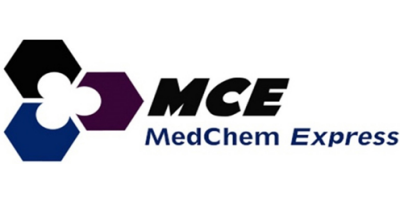

MedChemExpress - Model Genz-123346 free base - 491833-30-8
Genz-123346 free base is an orally available inhibitor of glucosylceramide synthase. Genz-123346 blocks the conversion of ceramide to glucosylceramide (GL1) and inhibits GM1 with an IC50 of 14 nM[1].MCE products for research use only. We do not sell to patients.
Genz-123346 free base
MCE China:Genz-123346 free base
Brand:MedChemExpress (MCE)
Cat. No.HY-12744
CAS:491833-30-8
Purity:99.80%
Storage:Powder -20°C 3 years 4°C 2 years In solvent -80°C 2 years -20°C 1 year
Shipping:Room temperature in continental US; may vary elsewhere.
Description:Genz-123346 free base is an orally available inhibitor of glucosylceramide synthase. Genz-123346 blocks the conversion of ceramide to glucosylceramide (GL1) and inhibits GM1 with an IC50 of 14 nM.
In Vitro:Exposure of cells to Genz-123346 and to other GCS inhibitors at nontoxic concentrations can enhance the killing of tumor cells by cytotoxic anti-cancer agents. Genz-123346 and a few other GCS inhibitors are substrates for multi-drug resistance efflux pumps such as P-gp (ABCB1, gP-170). In cell lines selected to over-express P-gp or which endogenously express P-gp, chemosensitization by Genz-123346 is primarily due to the effects on P-gp function[2]. Genz-123346(Genz) is an enhancer of autophagy flux[3].
In Vivo:In the Zucker diabetic fatty rat, Genz-123346 loared glucose and A1C levels and improved glucose tolerance. Drug treatment also prevented the loss of pancreatic beta-cell function and preserved the ability of the animals to secrete insulin. In the diet-induced obese mouse, treatment with Genz-123346 normalized A1C levels and improved glucose tolerance. The oral bioavailability of the drug is shown to be about 10% and 30% in mice and rats, respectively, with a half-life in plasma of 30–60 min[1]. Genz-123346 treatment results in a dose-dependent reduction of renal GlcCer and GM3 levels that translates into effective inhibition of cystic disease. A direct effect of Genz-123346 on the Akt-mTOR signaling pathway is observed, with reduced phosphorylation of Akt and ribosomal protein S6[4].
Animal Administration:Rats: Genz-123346 is dissolved in water. Zucker diabetic fatty rats treated with Genz-123346 (75 mg/kg) for 6 weeks are fasted overnight. The following morning, the fasted rats are anesthetized and injected with 5 units human insulin into the hepatic portal vein. Quadriceps muscle and liver are harvested 2 min after injection and immediately frozen in liquid nitrogen. Insulin receptor is immunoprecipitated. The immunoprecipitates are analyzed by immunoblotting[1]. Mice: C57BL/6 mice are fed on a high-fat (45% of kcal) diet for 8 weeks, obese mice with comparable body weight gain, glucose, and insulin levels are assigned to either the treated or control groups. The mice are then gavaged daily with Genz-123346 or water for 10 weeks[1].
IC50 & Target:IC50: 14 nM (GM1)[1] In Vitro Exposure of cells to Genz-123346 and to other GCS inhibitors at nontoxic concentrations can enhance the killing of tumor cells by cytotoxic anti-cancer agents. Genz-123346 and a few other GCS inhibitors are substrates for multi-drug resistance efflux pumps such as P-gp (ABCB1, gP-170). In cell lines selected to over-express P-gp or which endogenously express P-gp, chemosensitization by Genz-123346 is primarily due to the effects on P-gp function[2]. Genz-123346(Genz) is an enhancer of autophagy flux[3]. MedChemExpress (MCE) has not independently confirmed the accuracy of these methods. They are for reference only. 0 --> Genz-123346 free base Related Antibodies
Hot selling product:SM-164 | S63845 | Biotin-azide | Neocarzinostatin | Indocyanine green | Celecoxib | BX795 | Cholesterol | Subasumstat | Rucaparib
Trending products:Recombinant Proteins | Bioactive Screening Libraries | Natural Products | Fluorescent Dye | PROTAC | Isotope-Labeled Compounds | Oligonucleotides
References:
[1]. Zhao H, et al. Inhibiting glycosphingolipid synthesis improves glycemic control and insulin sensitivity in animal models of type 2 diabetes. Diabetes. 2007 May;56(5):1210-8. [Content Brief]
[2]. Chai L, et al. The chemosensitizing activity of inhibitors of glucosylceramide synthase is mediated primarily through modulation of P-gp function. Int J Oncol. 2011 Mar;38(3):701-11. [Content Brief]
[3]. Shen W, et al. Inhibition of glucosylceramide synthase stimulates autophagy flux in neurons. J Neurochem. 2014 Jun;129(5):884-94 [Content Brief]
[4]. Natoli TA, et al. Inhibition of glucosylceramide accumulation results in effective blockade of polycystic kidney disease in mouse models. Nat Med. 2010 Jul;16(7):788-92. [Content Brief]
Brand introduction:
• MCE (MedChemExpress) has a global exclusive compound library of more than 200 kinds, and we are committed to providing the most comprehensive range of high-quality small molecule active compounds for scientific research customers around the world;
• More than 50,000 highly selective inhibitors and agonists are involved in various popular signaling pathways and disease areas;
• The products cover a variety of recombinant proteins, peptides, commonly used kits, more PROTAC, ADC and other characteristic products, widely used in new drug research and development, life science and other scientific research projects;
• Provide virtual screening, ion channel screening, metabolomics analysis detection analysis, drug screening and other professional technical services;
• It has a professional experimental center and strict quality control and verification system;
• Provide LC/MS, NMR, HPLC, chiral analysis, elemental analysis and other quality inspection reports to ensure the high purity and high quality of products;
• The biological activity of the products has been verified by the experiments of customers in various countries;
• A variety of top journals such as Nature, Cell, Science and pharmaceutical patents have included the scientific research results of MCE customers;
• Our professional team tracks the latest pharmaceutical and life science research and provides you with the latest active compounds in the world;
• It has established long-term cooperation with the world's major pharmaceutical companies and well-known scientific research institutions。
